iPad 4 (Late 2012) Review
by Anand Lal Shimpi on December 6, 2012 4:40 PM ESTDisplay Analysis
The 4th gen iPad retains the same Retina Display as its predecessor. The 9.7-inch 2048 x 1536 display looks just as good as it did earlier this year. Brightness, black levels and contrast are all very good. The real advantage however is color accuracy thanks to Apple's factory calibration on all of its devices with an integrated display.
As with all of Apple's other Retina Displays, software support is made easy through integer scaling. The 2048 x 1536 resolution is an increase of 2x in both dimensions over the standard iPad/iPad mini resolution. App developers simply have to provide 2x scaled assets in order to make the most of the Retina Display. Deciding what image to load (standard res or 2x scaled) is handled automatically, the developer just needs to ensure that it's supplying both sets of images for the best user experience. Games can run either at the panel's native resolution, or run at a non-native offscreen resolution and simply scale up to the panel resolution if the title's performance requirements are too high (more on this later).
All first party apps and most of the 3rd party iPad apps I use on a regular basis are already Retina aware.
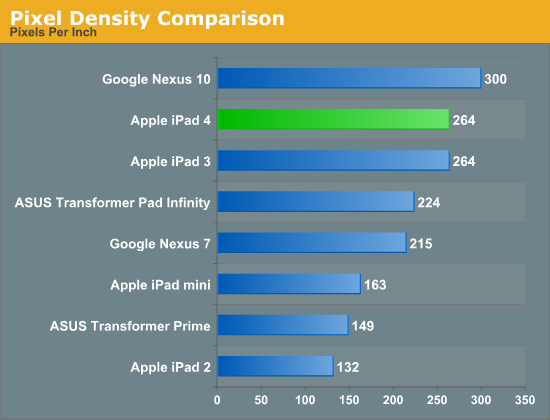
The big advantage the Retina Display offers over other iPads is a much better text reading experience. Individual letters look so much smoother:

I borrowed the paragraph shots below from our iPad mini review to give a better idea of how much of an improvement the Retina Display delivers when reading text:
Images also benefit from the Retina panel, but the advantage here ends up mostly being the accuracy of the display rather than the pixel density.

iPad mini (left) vs. iPad 4 (right)
With the exception of the 3rd generation iPad, only the Nexus 10 boasts any real competition to the iPad 4's display. I don't have a Nexus 10 on hand but Brian ran our suite of display tests on his review unit. Let's see how the two stack up in basic brightness and contrast measurements:
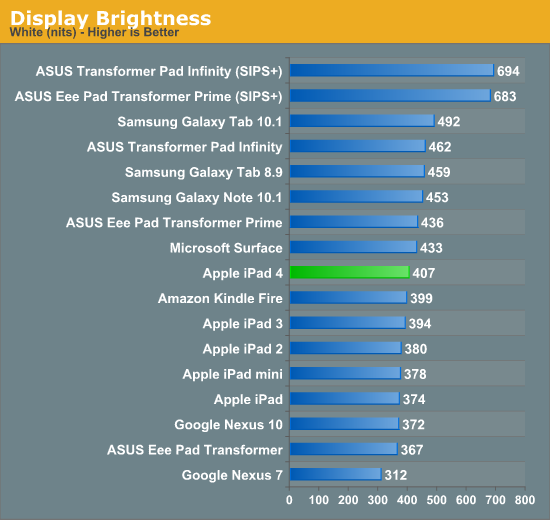
It's amazing to me that 400 nits on a nearly 10-inch display is simply middle of the pack now in modern tablets. This is just awesome. Look at any of our value notebook reviews and you'll find a bunch of displays that typically max out at sub 300 nits. It's no wonder that tablet sales are doing very well among consumers.
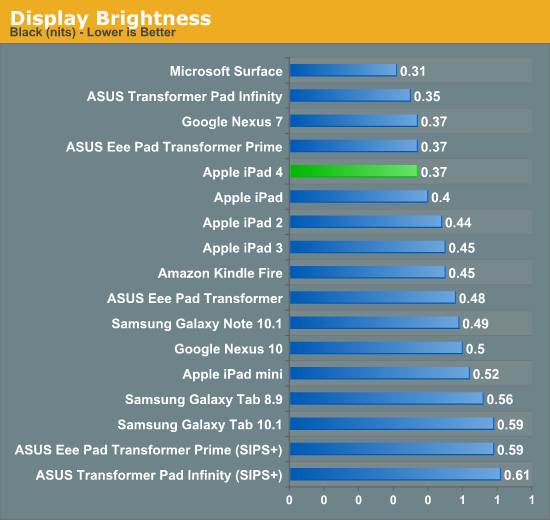
Black levels are good on the 4th generation iPad. Microsoft still holds the clear lead in black levels with its Surface RT, thanks to the tablet's bonded coverglass and display stack.
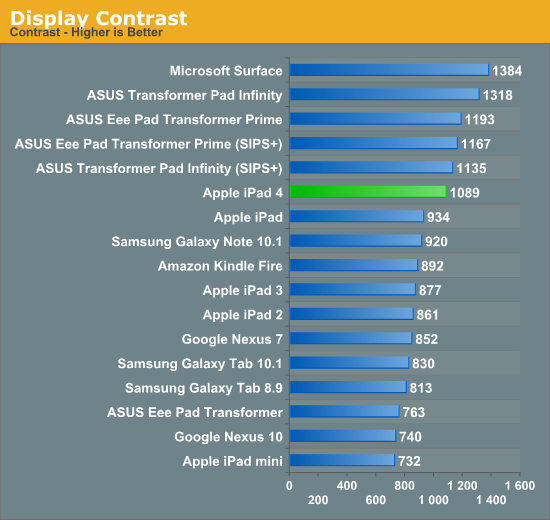
Overall contrast ratio is very good on the iPad 4. I measured a significant improvement over my iPad 3, although I suspect that has to do more with improvements to panel manufacturing than anything more deliberate.
Maintaining good brightness while pushing pixel density is only part of the equation. What made the iPad 3's display so great was that it shipped well calibrated from the factory. I assumed the same would be true for the 4th generation iPad, but I still needed to test to confirm.
To evaluate color accuracy I turned to our own Chris Heinonen's CalMAN smartphone/tablet workflow. We'll start off by looking at the calibrated white point for these tablets. What you're looking for here is a number close to 6500K:
Apple has been drifting north of 6503K for a while now. Variation in white point does seem to track well with individual panel makers in the iPad, so you may see numbers move around here depending on your luck of the draw. We've seen this in other iDevices in the past where whites will range from yellow to blue depending on what panel you end up with.
The next three charts look at accuracy represented as a difference between various source colors and what's reproduced on the display. The results are presented as average dE2000, with lower numbers being better.
First up is Grayscale performance, here we're looking at the accuracy of black, white and 19 shades of gray spread in between the two extremes:
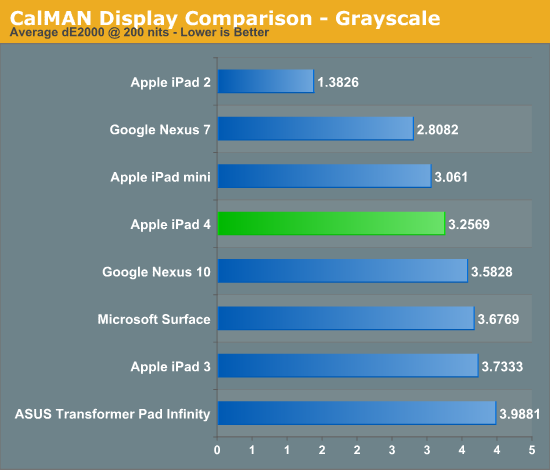
The 4th gen iPad does pretty well here, just edging out the Nexus 10 but losing to the iPad 2 and mini. Pretty much all of the tablets do a good job here at accurately reproducing grays.
First in our color accuracy tests is a saturation sweep. Here we're looking at 20%, 40%, 60%, 80% and 100% saturations of red, blue, green, magenta, yellow and cyan.
This is what you get with the iPad's pre-calibrated Retina Display: appreciably better color accuracy than any other tablet on the market today. I even measured an improvement in color accuracy compared to last year's iPad 3, however my iPad 3 was from the initial runs of production. I have noticed pretty significant variance between color accuracy between iPads. The results are always good, but some are definitely better than others.
Gamut CIE Chart
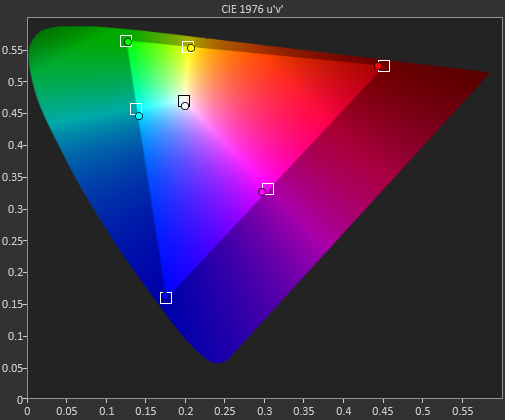
Saturation CIE Chart
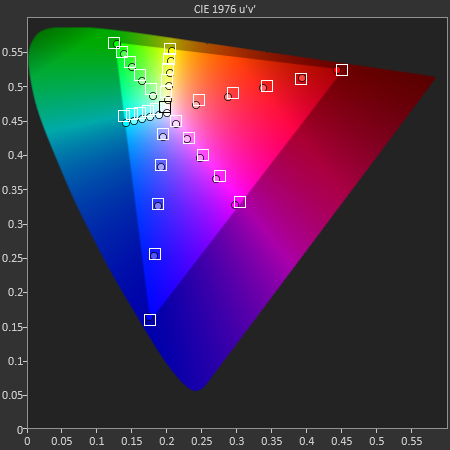
For our final accuracy test we're looking at the difference between a Gretag Macbeth colorchecker chart and the rendered swatches on these displays. Once again, lower numbers are better.
Many of the panels used here are actually good panels, the difference really boils down to calibration. Apple continues to dominate in terms of calibrated color accuracy. The 4th gen iPad's display remains the best in the industry from a color accuracy standpoint.
GMB Color Checker
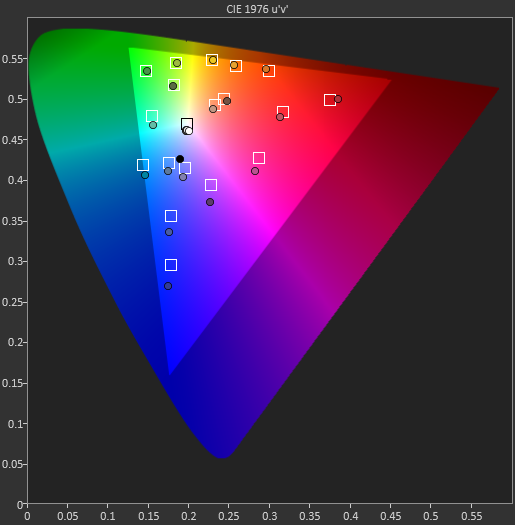




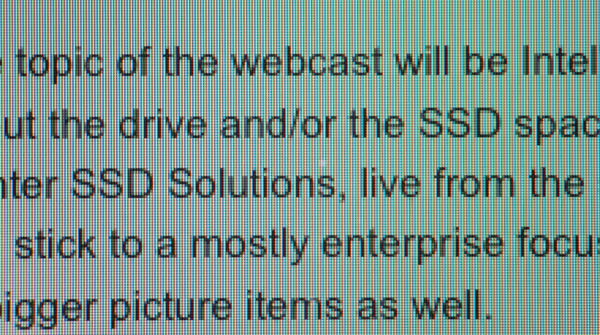
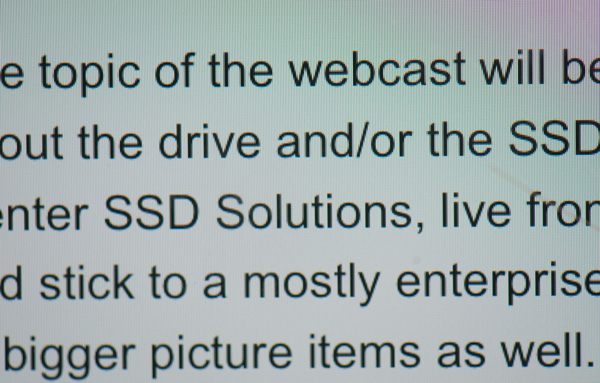
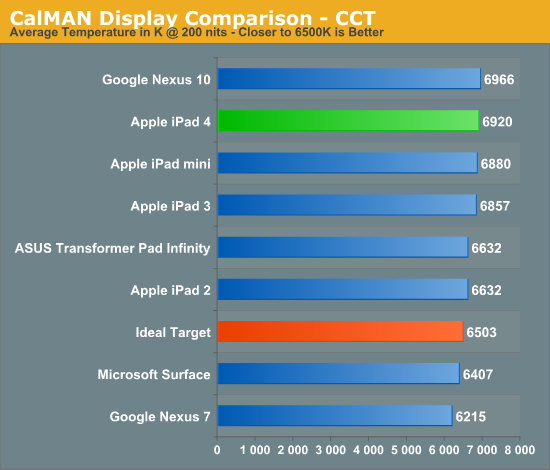
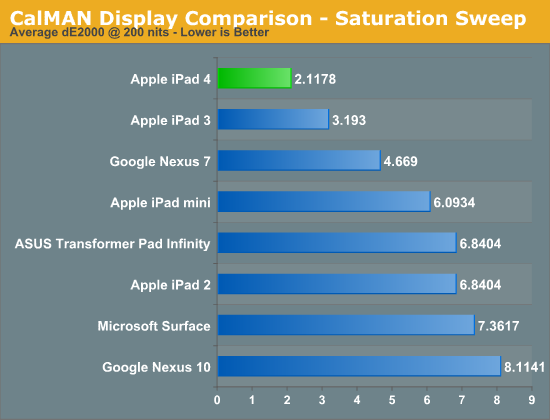
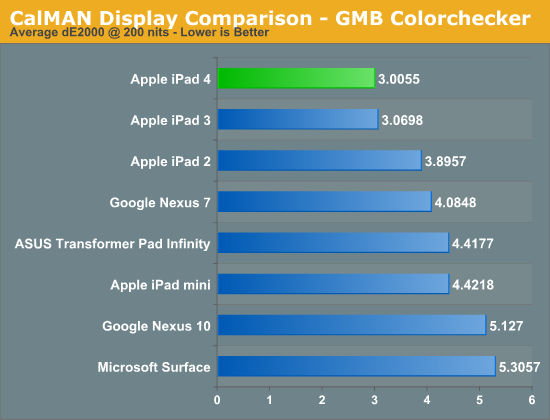








113 Comments
View All Comments
darkcrayon - Saturday, December 8, 2012 - link
I agree totally. I use Splashtop remote. It's pretty CPU intensive on both the client and server end (but is probably the fastest remote app I've used - it's capable of watching video at OK framerates- and with sound). It's much better on the 4th gen iPad just because the 3rd was hitting 100% doing some things.Death666Angel - Saturday, December 8, 2012 - link
The old charger was 10W, the new one is 12W. The old one drew 12.44W at the wall. The new on draws 13.57W at the wall. You say the new one delivers 9% more power, based on your measurement at the wall. The way you write it seems wrong to me. You are not measuring the power delivery of the chargers (which should be 10/12W), because you don't know their efficiency. It could be that the new charger delivers 20% more power as advertised and that the 9% increase in power draw simply means it has a better efficiency.Zink - Saturday, December 8, 2012 - link
+1GabeA - Saturday, December 8, 2012 - link
Sorry to burst the collective bubble here, but in your breathless haste to talk about the objective quality of the screen, you missed one tiny detail: the display stack in action.I don't think it takes more than a playthrough of a dark movie (or animation content) to see what I mean. In dim movies, contrast, brightness, backlight (yes, backlight, even with auto-brightness turned off), tint, and color balance fluctuate wildly, producing flickering and pumping, color changes, and other horribly destructive qualities that do not do the display justice.
Watching video on the iPad 4 -- particularly dark video in a dark room -- is quality suicide. There are threads devoted to the topic online. Colors are hilariously washed and change constantly within a scene, which is beyond annoying when watching a relatively static scene. White subtitles fade to a deep gray. Gray stone walls becomes light blue, then deep purple, then back to gray.
http://forums.macrumors.com/showthread.php?t=14841...
Booster - Sunday, December 9, 2012 - link
This POS ain't no 'computer'. More like a picture frame, just about as useful.LordConrad - Sunday, December 9, 2012 - link
Stop trolling. Just because you find it useless doesn't mean that others will.LordConrad - Sunday, December 9, 2012 - link
I sold my iPad 3 and used the money towards a new iPad 4. I have noticed a huge speed increase in iOS and applications after getting the iPad 4. Switching to the lightning connector was a bit annoying, but I'm glad I upgraded to the 4. This is what the iPad 3 should have been.batguiide - Sunday, December 9, 2012 - link
Sharea website with you ,
( socanpower. ca )
Believe you will love it.
laptop battery,CPU fan,AC power adapters.DC power adapters and laptop keyboard.
I bought two. Cheap, good quality, you can
go and ship with there.
prdola0 - Monday, December 10, 2012 - link
Seriously, what is wrong with the picture quality bias on AnandTech? Most if not all Apple gear is photographed in a polished state, notebooks opened, gadgets turned on (and if not, only to produce a pretty little reflection effect), with fancy backgrounds and fancy picture effects (depth of fields, etc.). Yet, other manufacturers are treated like second-class, with notebooks closed, devices smudgy, on dirty and smudgy backgrounds, turned off with no screen picture. Just look at the background in the Goodle Nexus article, or compare the recent MacBook and other notebook articles.I have noticed that Apple stuff is creeping in more and more. Well, I don't like it but I can live with that. But why the hell this incredible, very unprofessional bias? I have asked this question before and did not get an aswer. So here it is again.
IKeelU - Monday, December 10, 2012 - link
I just checked the shots in the Nexus 7 review and they seem pretty clean and comparable to those in this review. Maybe the tablet reviews are better photographed than the laptop reviews?